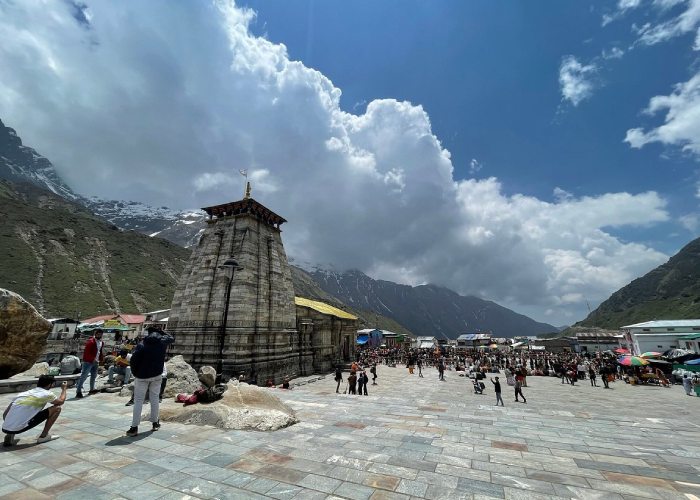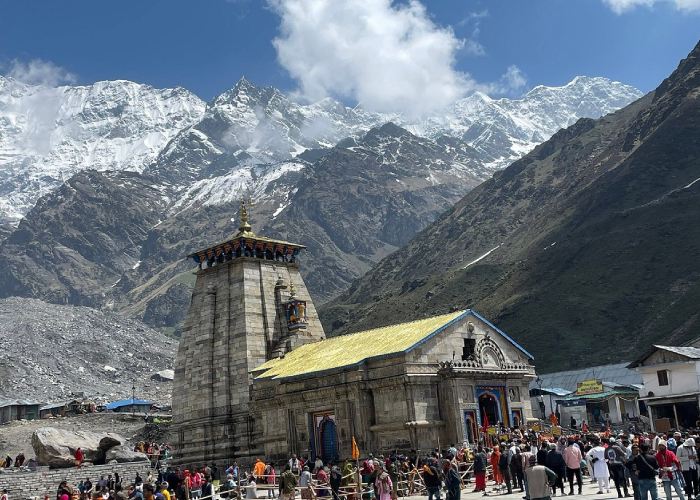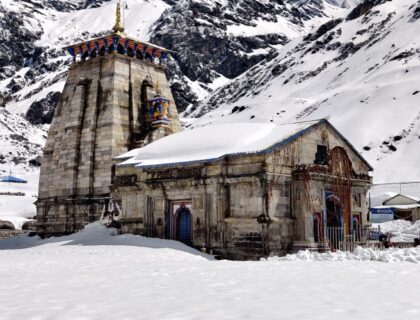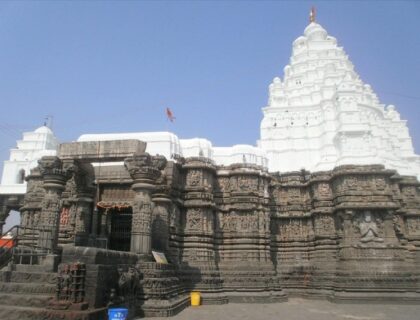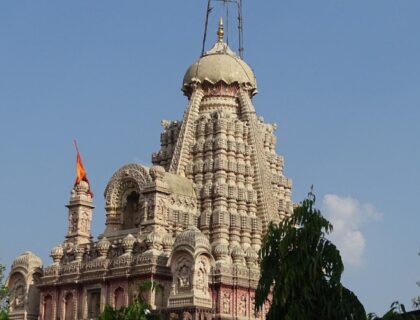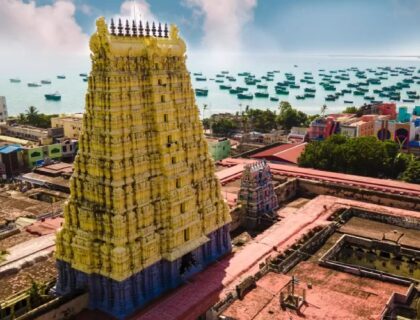Kedarnath Jyotirling
Kedarnath Jyotirling Temple is a Hindu temple and one of Shiva’s twelve jyotirlingas, located on the Garhwal Himalayan range near the Mandakini river in the Indian state of Uttarakhand. Kedarnath temple is a sacred pilgrimage site in Northern India, located on the Mandakini River’s bank at an elevation of 3584 metres above sea level. The historical name of this region is “Kedar Khand”. Kedarnath temple is one of the 12 Jyotirlingas of Lord Shiva in India and is part of the Char Dhams and Panch Kedar in Uttarakhand.
The Kedarnath Jyotirling Temple is only open to the public between April (Akshaya Tritiya) and November (Kartik Purnima, the autumn full moon) due to severe weather. The temple’s vigraha, or deity, is brought to Ukhimath for six months of worship during the winter. It is believed that Kedarnath is the same form of Shiva, the “Lord of Kedarkhand,” the historical name of the area.
Story Behind Kedarnath Jyotirling Temple
The legend behind this well-known place of worship is that following the Mahabharata war, the Pandavas performed a penance to atone for their sins – killing their brothers. They were advised to seek Lord Shiva’s forgiveness in order to do so. They looked everywhere and finally found Lord Shiva at the location of the jyotirlinga in Kedarnath today.
Lord Shiva is said to have hidden himself from the Pandavas because he was unwilling to forgive them for their deception and sins during the war. He disguised himself as a bull and vanished into the earth.

Bhimasena, the second Pandava, tried to pull him out of the ground by pulling on his tail and hind legs. Lord Shiva, on the other hand, dug himself deeper and only reappeared in fragments in various locations: the hump in Kedarnath, the arms in Tunganath, the navel and stomach in Madhyamaheshwar, the face in Rudranath, and the hair and head in Kalpeshwar.
The Pandavas erected temples to Shiva in these five locations, known as the Panch Kedars. This cleansed them of their sins. Lord Shiva also promised to remain in the sacred location as a triangular jyotirlinga. This is why Kedarnath is so well-known and revered among devotees.
Kedarnath Jyotirling Temple History
According to Hindu tradition, Lord Shiva manifested himself in the form of Jyotirlingam, or cosmic light. There are 12 such Jyotirlingas, with Kedarnath being the highest. This magnificent temple was built over a thousand years ago by Jagad Guru Adi Shankaracharya. It is situated in Uttarakhand’s Rudra Himalaya range. It is located at an elevation of 3,581 metres and is a 16-kilometer trek from the nearest town of Gaurikund.
The Kedarnath temple is made of massive stone slabs that are laid out over a large rectangular platform. The temple is reached via large grey Steps that lead to the Holy Sanctums. On the steps, we can see inscriptions in Pali.

The Kedarnath Teerth Purohits are the region’s ancient Brahmins; their ancestors (Rishi-Muni) have worshipped the lingam since the time of Nara-Narayana and Daksh Prajapati. King Janmejay, the Pandavas’ grandson, granted them the right to worship at this temple and donated the entire Kedar region, and pilgrims have been worshipping there ever since.
The Kedarnath Temple is said to have been built by the Pandavas, and Adi Shankara redesigned it in 8 AD. In essence, the magnificent Kedarnath Temple has stood the test of time for more than a thousand years. Geologists assert that during the Little Ice Age, Kedarnath Temple was covered in snow for 400 years. The Little Ice Age is the period between 1300 and 1900 AD.

On June 16 and 17, 2013, the Kedarnath valley, along with other parts of Uttarakhand, experienced unprecedented flash floods. The surrounding areas were severely damaged, but the temple structure was surprisingly protected by a large rock which is now called as Bhima Rock that appeared before the temple and protected during the floods. Later, inspection and analysis by investigating teams revealed that the temple structure was unharmed, despite the need for clean-up, repair, and reconstruction of the surrounding areas. Devotees consider Lord Shiva’s grace to be the strength of the ancient temple of Kedarnath.
Architecture of Kedarnath Jyotirling Temple
The presiding image of Kedarnath, in the form of a lingam, has an irregular shape and a pedestal that measures 3.6 m (12 ft) in circumference and 3.6 m (12 ft) in height. In front of the temple is a small pillared hall with images of Parvati and the five Pandava princes.
The first hall inside Kedarnath Temple houses statues of the five Pandava brothers, Krishna, Nandi, Shiva’s vehicle, and Virabhadra, one of Shiva’s guards. The main hall also contains statues of Draupadi and other deities. The head of a man carved in the triangular stone lingam is an unusual feature of the temple.

A similar head can be found carved in another temple nearby, which was built on the site of Shiva and Parvati’s marriage. Adi Shankara is credited with reviving this temple, as well as Badrinath and other Uttarakhand temples; he is said to have attained Mahasamadhi at Kedarnath. Adi Sankara’s samdhi mandir is located behind the temple.
Facts about Kedarnath Jyotirling Temple
- Kedarnath Dham Jyotirling is among the famous pilgrimage sites for Lord Shiva devotees.
- Kedarnath, located on the Mandakini River’s banks, attracts millions of pilgrims each year.
- A similar head can be found carved in another temple nearby, which was built on the site of Shiva and Parvati’s marriage.
- Adi Shankara is credited with reviving this temple, as well as Badrinath and other Uttarakhand temples; he is said to have attained Mahasamadhi at Kedarnath. Adi Sankara’s samdhi mandir is located behind the temple.
- The temple is inaccessible by road and must be reached via a 22-kilometer (14-mile) uphill trek from Gaurikund. Kedarnath Temple could be reached via an 18 km trek from Gaurikund or by Helicopter from Phata.
- The temple can be reached by pony, mule, or manchan.
- According to Hindu legends, the Pandavas built the temple, which is one of the twelve Jyotirlingas, or Shiva’s holiest Hindu shrines.
- The temple is the first of the Panch Kedar pilgrimage sites and one of the four major sites in India’s Chota Char Dham pilgrimage of the Northern Himalayas.
- The word Kedarnath signifies “the god of the Kedar,” derived from the Sanskrit words kedara (“field”) and natha (“lord”).
- According to the Kashi Kedara Mahatmya text, the name “Kedarnathis” comes from the fact that “the crop of liberation” grows there.
Famous Festivals In Kedarnath Jyotirling Temple
- Badri-Kedar Utsav – This festival is celebrated in the month of June with great joy when Phatak of the temple is opened after six months of closure.
- Shravani Annakoot Mela – This festival is celebrated on the day before Raksha Bandhan.
- Samadhi Pooja – On this day when the Kedarnath Temple closes for six months
- Mahashivratri –The Maha Shivaratri festival is a grand event at Kedarnath Jyotirling temple, as it is at all important Shiva temples. It is the main festival in town. Every year, millions of devotees flock to this town to catch a glimpse of the Lord on this auspicious day, which falls in February/March
How to Reach Kedarnath Jyotirling Temple
The best time to visit the Kedarnath Jyotirling Temple is from April/May to June and September to October/November.
By Air: Jollygrant Airport is the closest airport to Kedarnath Jyotirling Temple
By Rail: The nearest railway station to Kedarnath Jyotirling Temple is Rishikesh.
By Road: Gaurikund is connected by motorable roads, and buses and taxis from important destinations like Rishikesh, Dehradun, Uttarkashi and Tehri, Pauri and Chamoli are easily available. You can reach Kedarnath Jyotirling Temple by choosing any of the options.
Also Read – Somnath Jyotirling
Location
Facilities
- Drinking Water
- Pooja Item Shops
- Prasad Shops
- Resting Room






